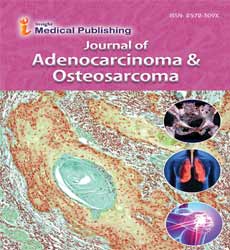Abstract
Tumor Growth Pattern is Significantly Associated with Metastasis in Patients Diagnosed with Colon Carcinoma ÃÆâÃâââ¬Ãâââ¬Å A Computer Image Analysis Study
Background and aim: Growth pattern of the tumor has been studied for its association with survival in colorectal cancer. Among different growth pattern evaluating techniques, very little is known about prognostic significance of complexity index. The aim of this study was to develop a prognostic model, which could be used to predict prognosis in the patients diagnosed with colon carcinoma. Materials and methods: Formalin fixed paraffin embedded tissues samples from 316 patients diagnosed with colon carcinoma were used in this study. The slides were stained for cytokeratin-8 and images of the invasive front of the tumor were captured using a camera mounted onto a microscope. Images were thresholded in order to get the tumor area black and the surrounding tissue white. The tumor outline was also highlighted as a single pixel line to calculate the fractal dimension and number of tumor cells and tumor cell clusters. These two features were then used to calculate the complexity index by performing a tree diagram analysis. Complexity index was correlated with 5-years survival and other clinicopathological data (age, gender, tumor penetration, lymph node metastasis, duke’s stages, anatomical localization and differentiation of the tumor) of the patients. Results: Clinicopathological parameters like tumor metastasis, localization, gender and differentiation were significantly associated with tumor complexity index with p=0.000, p=0.002, p=0.024 and p=0.000 respectively. A positive trend was also observed between complexity index of tumor and age variable (p=0.051). Tumor wall penetration, lymph node metastasis and Duke’s stages were not significantly associated with tumor growth pattern; complexity index with p=0.997, p=0.857, p=0.783 and p=0.647 respectively. Conclusion: We conclude that complexity index is associated with systemic metastasis and tumor differentiation in patients diagnosed with colon carcinoma. Complexity index is a reliable objective and quantitative technique used to analyse tumor characteristics and can be used as a prognostic tool in the individual treatment of colon carcinoma
Author(s):
Abrar Ahmad and Victoria Hahn-Stromberg
Abstract | Full-Text | PDF
Share this

Abstracted/Indexed in
- Google Scholar
- Secret Search Engine Labs
Open Access Journals
- Aquaculture & Veterinary Science
- Chemistry & Chemical Sciences
- Clinical Sciences
- Engineering
- General Science
- Genetics & Molecular Biology
- Health Care & Nursing
- Immunology & Microbiology
- Materials Science
- Mathematics & Physics
- Medical Sciences
- Neurology & Psychiatry
- Oncology & Cancer Science
- Pharmaceutical Sciences
